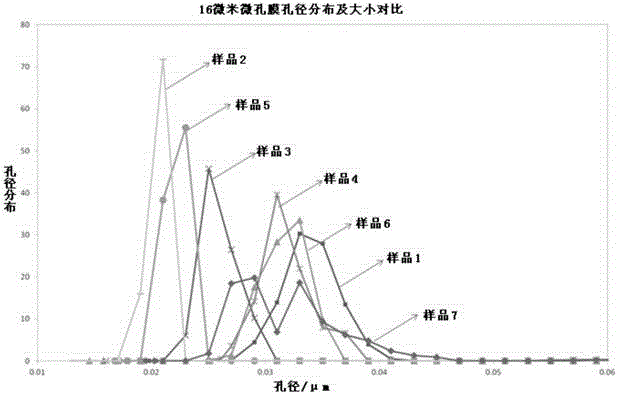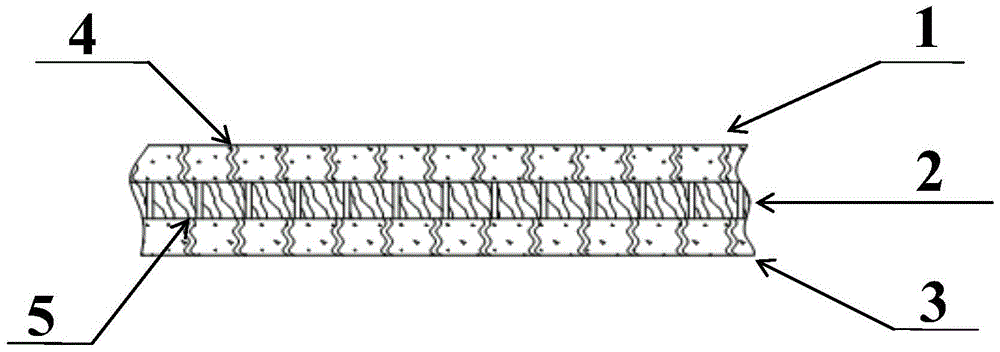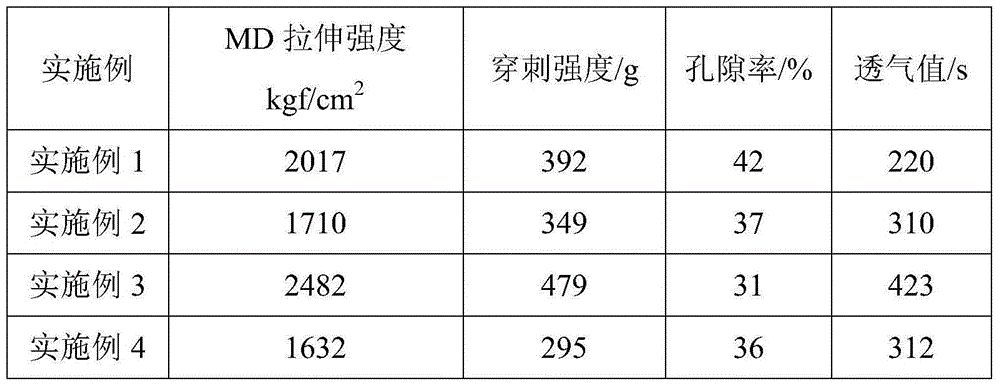Preparation method of multi-layer lithium battery diaphragm with high security
A lithium battery diaphragm and functional layer technology, which is applied in the field of microporous membranes, can solve the problems of cumbersome process flow, large environmental pollution, and numerous procedures, and achieve the effects of uniform pore size distribution, low equipment investment cost, and perfect equipment process technology
- Summary
- Abstract
- Description
- Claims
- Application Information
AI Technical Summary
Problems solved by technology
Method used
Image
Examples
Embodiment 1
[0026] Calcium carbonate (CaCO 3 ) powder is added to polypropylene at a mass ratio of 30%, and then extruded with polypropylene resin through a three-layer co-extrusion casting die to form a precursor film with a three-layer structure of A-B-A, and the A layer is CaCO 3 Mixed layer with polypropylene, layer B is polypropylene layer, three-layer extrusion thickness ratio is 20:60:20. The precursor film is cooled and formed by casting rolls to complete the casting process. The precursor film was heat-treated at 140° C. for 4 hours to obtain heat treatment. The heat-treated film is laminated in two layers by special lamination equipment, and the lamination temperature is 50°C.
[0027] The heat-treated film after 2-layer composite is stretched in the mode of 6 unwinding and 12 layers of stretching, the stretching temperature is 140°C, and the stretching ratio is 2 times to obtain the finished product.
Embodiment 2
[0029] Aluminum hydroxide (Al(OH) 3 ) powder is added to polypropylene at a mass ratio of 50%, and then extruded with polypropylene resin through a three-layer co-extrusion casting die to form a precursor film with a three-layer structure of A-B-A, and the A layer is Al(OH) 3 Mixed layer with polypropylene, layer B is polypropylene layer, and the extrusion thickness ratio of the three layers is 15:70:15. The precursor film is cooled and formed by casting rolls to complete the casting process. The precursor film was heat-treated at 130° C. for 8 hours to obtain a heat-treated film. The heat-treated film is laminated in three layers by special lamination equipment, and the lamination temperature is 30°C.
[0030] The heat-treated film roll after 3-layer lamination is stretched in the mode of 4 unwinding and 12 layers of stretching, the stretching temperature is 120°C, and the stretching ratio is 1.5 times to obtain the finished product.
Embodiment 3
[0032] Calcium carbonate (CaCO 3 ) powder is added to polyester at a mass ratio of 30%, and then extruded with polypropylene resin through a three-layer co-extrusion casting die to form a precursor film with a three-layer structure of A-B-A, and the A layer is CaCO 3 The mixed layer with polyester, the B layer is a polypropylene layer, and the three-layer extrusion thickness ratio is 10:80:10. The precursor film is cooled and shaped by casting rolls to complete the casting process. The precursor film was heat-treated at 120° C. for 12 hours to obtain a heat-treated film. The heat-treated film is laminated in 4 layers by special composite equipment, and the composite temperature is 60°C.
[0033] The heat-treated film roll after 4-layer lamination is stretched in the mode of 4 unwinding and 16 layers of stretching, the stretching temperature is 100°C, and the stretching ratio is 2.5 times to obtain the finished product.
PUM
 Login to View More
Login to View More Abstract
Description
Claims
Application Information
 Login to View More
Login to View More - R&D
- Intellectual Property
- Life Sciences
- Materials
- Tech Scout
- Unparalleled Data Quality
- Higher Quality Content
- 60% Fewer Hallucinations
Browse by: Latest US Patents, China's latest patents, Technical Efficacy Thesaurus, Application Domain, Technology Topic, Popular Technical Reports.
© 2025 PatSnap. All rights reserved.Legal|Privacy policy|Modern Slavery Act Transparency Statement|Sitemap|About US| Contact US: help@patsnap.com



